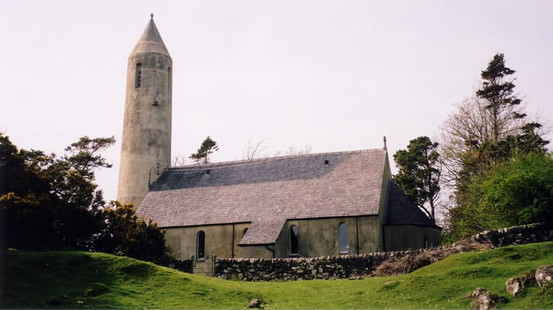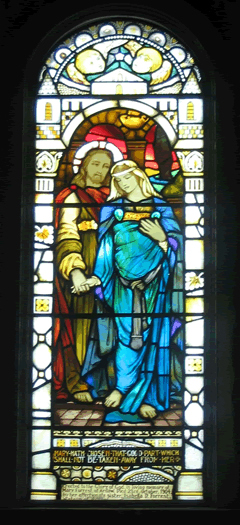Sacred Connections Scotland
The intriguing mystery of a stained glass window in
Kilmore Church, Dervaig, on the Scottish Isle of Mull
Barry Dunford
In the small village of Dervaig, which translates from the gaelic as “little grove”, on the Scottish western Isle of Mull, is to be found a church with an unusual architectural style and feature. The present Kilmore Church (Church of Mary) was built in 1905 on an earlier religious site. It was constructed with a peculiarly distinct round tower feature. The leading Scots architect responsible for building Kilmore Church was Peter MacGregor Chalmers (1859-1922) who had worked with the design of a number of churches throughout Scotland.

Kilmore Church, Dervaig, Isle of Mull
Inside Kilmore Church are to be found seven very striking stained glass windows, one of which reveals a remarkable symbolism. This particular stained glass window appears to date from 1906, one year after the construction of the church itself, and was produced by Stephen Adam, a leading Scottish stained glass artist who died in 1910. Although it is not known for certain who commissioned the design for this extraordinary stained glass window, its remarkable symbolic representation can hardly have escaped the attention of Stephen Adam, the stained glass artist responsible, who nevertheless agreed to carry out this explosively symbolic portrayal.

Jesus and Mary Magdalene, Kilmore Church, Dervaig, Isle of Mull
This striking stained glass window shows a young man portrayed with the usual features attributed to Jesus with a halo above his head, holding hands with a woman without a halo. In iconography, a halo with a cross (as seen in the above stained glass window) uniquely symbolises Jesus the Christ. The woman can clearly be seen to be portrayed pregnant with her girdle painted below her abdomen rather than around her waist. The key to the identity of this woman is made plain by the gospel text which appears immediately below the pregnant woman. It reads: “Mary hath chosen that good part, which shall not be taken away from her“. This statement, made by Christ himself, which relates to Mary of Bethany whom some have identified with Mary Magdalene, can be found in the Gospel of Luke, ch. 10, v. 42. The complete relevant text from Luke, ch. 10, v. 38-42, reads as follows:
38. “Now it came to pass, as they went, that he entered into a certain village: and a certain woman named Martha received him into her house.
39. And she had a sister called Mary, which also sat at Jesus’ feet, and heard his word.
40. But Martha was cumbered about much serving, and came to him, and said, Lord, dost thou not care that my sister hath left me to serve alone? bid her therefore that she help me.
41. And Jesus answered and said unto her, Martha, Martha, thou art careful and troubled about many things:
42. But one thing is needful: and Mary hath chosen that good part, which shall not be taken away from her.”

Enlarged text from the above stained glass window portraying Jesus and Mary Magdalene
It would appear from the inclusion of this highly pertinent Gospel text that the couple holding hands in this enigmatic stained glass window are Jesus and Mary Magdalene. It is interesting to note that this remarkable stained glass window dates from nearly eighty years prior to the genre of books published from the early-1980’s onwards which allude to a possible holy marriage and sacred union between Jesus and Mary Magdalene and a Holy Bloodline of genealogical descent.
So key questions remain: who commissioned this extraordinary symbolic stained glass window which runs contrary to conventional Christian theology? And why was it placed in a Christian church on the Scottish western Isle of Mull?
The Scottish Grail Legacy – Artist Stephen Adam (3:26 mins video)